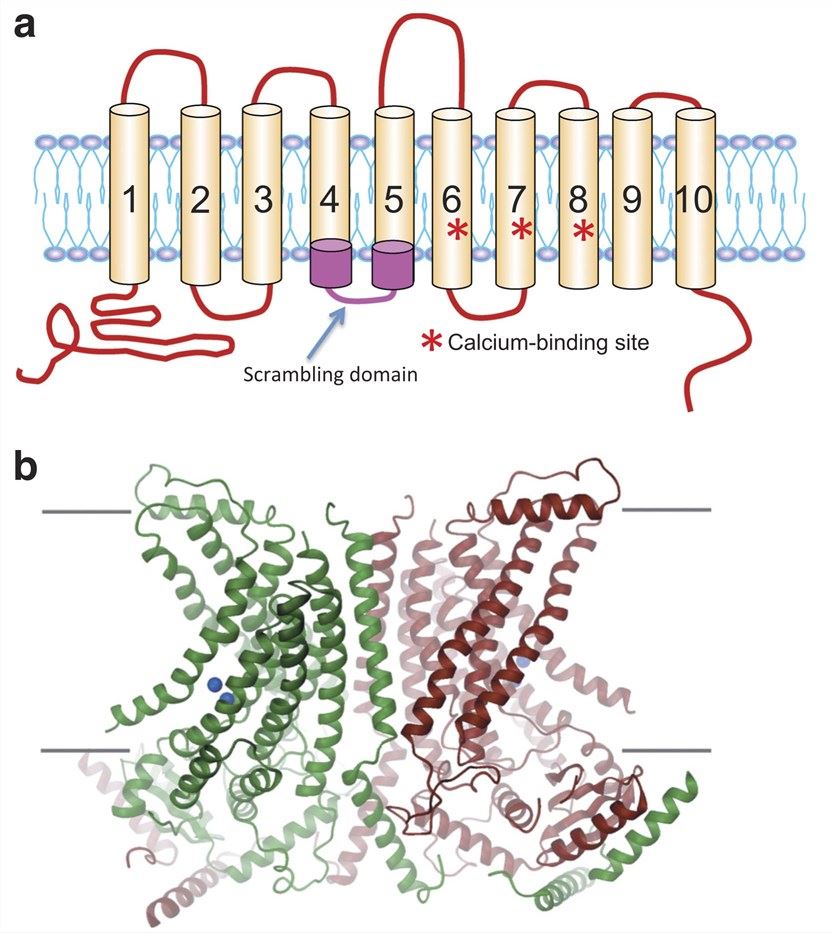Introduction of ANO5
ANO5 is encoded by the ANO5 gene. It belongs to the transmembrane protein 16 (TMEM16) family, which plays an important role in a variety of physiological processes including ion transport, phospholipid scrambling, as well as regulating other ion channels. ANO5 (also known as TMEM16E) possesses eight transmembrane domains and a re-entrant loop between the fifth and sixth transmembrane domains.
| Basic Information of ANO5 | |
| Protein Name | Anoctamin-5 |
| Gene Name | ANO5 |
| Aliases | Gnathodiaphyseal dysplasia 1 protein, Transmembrane protein 16E, TMEM16E |
| Organism | Homo sapiens (Human) |
| UniProt ID | Q75V66 |
| Transmembrane Times | 8 |
| Length (aa) | 913 |
| Sequence | MGDPDLLEVLAEEGEKVNKHIDYSFQMSEQSLSSRETSFLINEETMPAKRFNLFLRRRLMFQKNQQSKDSIFFRDGIRQIDFVLSYVDDVKKDAELKAERRKEFETNLRKTGLELEIEDKRDSEDGRTYFVKIHAPWEVLVTYAEVLGIKMPIKESDIPRPKHTPISYVLGPVRLPLSVKYPHPEYFTAQFSRHRQELFLIEDQATFFPSSSRNRIVYYILSRCPFGIEDGKKRFGIERLLNSNTYSSAYPLHDGQYWKPSEPPNPTNERYTLHQNWARFSYFYKEQPLDLIKNYYGEKIGIYFVFLGFYTEMLFFAAVVGLACFIYGLLSMEHNTSSTEICDPEIGGQMIMCPLCDQVCDYWRLNSTCLASKFSHLFDNESTVFFAIFMGIWVTLFLEFWKQRQARLEYEWDLVDFEEEQQQLQLRPEFEAMCKHRKLNAVTKEMEPYMPLYTRIPWYFLSGATVTLWMSLVVTSMVAVIVYRLSVFATFASFMESDASLKQVKSFLTPQITTSLTGSCLNFIVILILNFFYEKISAWITKMEIPRTYQEYESSLTLKMFLFQFVNFYSSCFYVAFFKGKFVGYPGKYTYLFNEWRSEECDPGGCLIELTTQLTIIMTGKQIFGNIKEAIYPLALNWWRRRKARTNSEKLYSRWEQDHDLESFGPLGLFYEYLETVTQFGFVTLFVASFPLAPLLALINNIVEIRVDAWKLTTQYRRTVASKAHSIGVWQDILYGMAVLSVATNAFIVAFTSDIIPRLVYYYAYSTNATQPMTGYVNNSLSVFLIADFPNHTAPSEKRDFITCRYRDYRYPPDDENKYFHNMQFWHVLAAKMTFIIVMEHVVFLVKFLLAWMIPDVPKDVVERIKREKLMTIKILHDFELNKLKENLGINSNEFAKHVMIEENKAQLAKSTL |
Function of ANO5 Membrane Protein
As the first member of the TMEM16 family which is reported to be associated with human diseases, ANO5 is highly expressed in human skeletal muscle, cardiac muscle, chondrocytes, and osteoblasts. Some clinical studies show an important role of ANO5 in the human musculoskeletal and cardiac systems. Meanwhile, some clinical studies support an essential role of ANO5 in the human musculoskeletal and cardiac systems. ANO5 is also involved in cardiac diseases as cardiac involvement was also reported in association with some ANO5-deficient patients. Mutations in ANO5 is reported to be associated with gnathodiaphysial dysplasia 1, which is a rare skeletal syndrome characterized by bone fragility. In addition, genetic defects in ANO5 are also reported to be responsible for autosomal recessive muscular dystrophies. There is no animal model with ANO5 deficiency even though the clear links of ANO5 deficiency to these genetic diseases in patients so far.
 Fig.1 Schematic representation and tertiary structure of ANO5. (Nagata, 2016)
Fig.1 Schematic representation and tertiary structure of ANO5. (Nagata, 2016)
Application of ANO5 Membrane Protein in Literature
This article reports a novel homozygous mutation in ANO5 gene identified from a Japanese male patient, who has marked elevation of creatine kinase (CK) level for more than 10 years with Limb girdle muscular dystrophy type 2L (LGMD2L) and suggests the possibility of ANO5 mutation associated with LGMD2L.
The results of this article present that the ANO5 knockout mice do not recapitulate ANO5-deficient muscular dystrophy and associated cardiomyopathy as in human patients. However, ANO5 knockout mice result in the change of gene expression pattern related to the lipid metabolism and complement signaling pathways.
This article shows that ANO5-patients may have an increased risk of ventricular arrhythmia because a high prevalence of ANO5 deficiency is found among patients with unclassified LGMD2 (46%) and MMD (100%).
This article demonstrates the expression of ANO5 in the gastrointestinal epithelium and in skeletal muscle in the esophagus for the first time and the novel finding facilitates the further investigation of the role of ANO5 in GI function.
The authors in this article apply a specific monoclonal N-terminal ANO5 antibody to analyze the expression pattern of human ANO5 protein. The results of this article indicate that the ANO5 protein expression is upregulated in ANO5-mutated muscular dystrophy.
ANO5 Preparation Options
To obtain the soluble and functional target protein, the versatile Magic™ membrane protein production platform in Creative Biolabs enables many flexible options, from which you can always find a better match for your particular project. Aided by our versatile Magic™ anti-membrane protein antibody discovery platform, we also provide customized anti-ANO5 antibody development services.
Creative Biolabs is the leading customer service provider that has extensive experience in in the field of membrane protein. Our teams are famous for successfully accomplishing numerous challenging projects including generation of many functional membrane proteins among our worldwide customers. Please feel free to contact us for more information.
Reference
All listed services and products are For Research Use Only. Do Not use in any diagnostic or therapeutic applications.